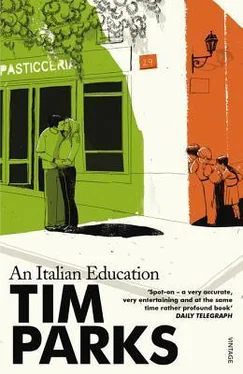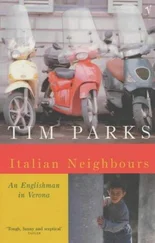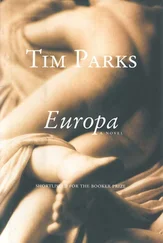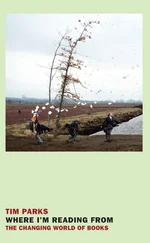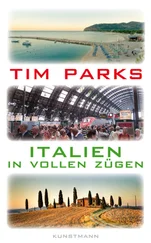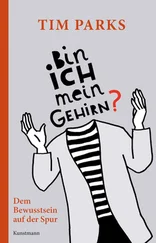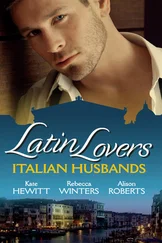‘Well, santa patata , Michele,’ I have to exclaim, ‘what has that Zia been telling you!’
Nor was the possibility of parental separation the only hard fact my boy must have learnt from Natalina. About a year after the children had started going to Zia’s, I remember crossing the road with him one day and hearing him remark that we would have to do this carefully if we didn’t want to end up like that little boy at the cemetery. Careful questioning revealed that Zia regularly put him on the handlebars of her bike when she went to place flowers on her mother’s grave at the cemetery (at least once a week). Once there, she always made a point of explaining to him that all the people whose photographs he could see on the tombstones and the grave niches were dead people, people who had been alive and living here in Montecchio for the most part (and often she could tell him the streets and houses where they lived), but who were now dead and confined in their coffins, until, after twenty years or so, they would be pulled out and someone new put in. The little red lights, she explained, beside the photographs, the lumini , were to indicate the presence of God. In particular, she showed him the grave and photograph of a little boy his own age who had been killed in a street accident in Piazza Buccari a couple of years before. This photograph made a big impression on Michele, who was clearly less impressed by the spiritual comfort of the little lights than by the thought of how drear and cold the graves were and how frightening to think of the once-alive-now-dead people inside them.
‘You have to look when you cross,’ he tells me solemnly, ‘if you don’t want your photo in the cemetery.’
Another place Zia regularly took Michele and, even more so, Stefi as she grew up, since Stefi was to go to Zia every weekday for two years and more, was the church, a large amorphous red-brick construction from the outside, but bright and airy within. She took them when she went just to pray and light a candle and she took them when she went to funerals. And Zia went to a lot of funerals. Indeed, I can think of nobody who goes to more funerals than Zia. Unless it was just that these were unfortunate years. Michele and Stefi got fairly used to the ceremony and learnt to insist on lighting candles. Stefi, as she grew into a little girl, became terribly impressed by how well everybody dressed at church, which she very soon realised was one of the main and best reasons for going there. If we passed a church on our walks, she would protest loudly until we went in and lit a candle. When she was around three and we took a holiday in England, she was most upset that there were no candles to light. And on the same holiday, when my mother was trying so delicately to explain why she didn’t have her beloved dog any more, using expressions like ‘Laddie isn’t with us now’ and ‘Laddie’s gone away to a better place,’ Michele said to Stefi with great frankness, ‘She means the dog’s dead. He must have tried to cross the road.’
In the beginning, then, there was the nido , then Zia, though Zia will never be entirely eclipsed, and finally the scuola materna , a sort of second-level nursery for three-to-six-year-olds, still optional, but as you only pay for the food, much more widely used than the nido . It’s here they start to teach the children things, including, though you may opt out, religion (Catholic, vocational); but if you do opt out, your child will be alone, unless perhaps there is an extra-comunitario , meaning a little black boy who is a moslem. Or another way of putting it would be to say that if you opt out — have your children opt out — you are yourself a moslem, a term that can be used to describe anyone beyond the pale. Not that the majority in the village are ‘staunch’ Catholics, or bigoted, or even, in most cases, remotely interested in matters religious, merely that they would no more dream of opting out of the catechism than of not greeting their parents with the appropriate, time-honoured embraces. Catholicism is still the default setting for those without preference in a supremely hedonistic Italy.
I asked the woman who was Michele’s and later Stefi’s teacher at the scuola materna what they actually did during the so-called ora di religione , the hour of religion (which, when you investigate, turns out to be two hours). Immediately, she began to apologise; she began to say that they hadn’t yet been granted a specific teacher for religion, so they found it difficult to cover the whole programme, established apparently in liaison with the church and including every major issue of faith. They found it difficult, she said, to teach the little children everything they were supposed to. I smiled to think that this slim, gaunt woman, who likes to wear a stooped, professional, worried look, had imagined that I, protestant by birth and sentiment, atheist by conviction, was one of those who worried that the children weren’t getting enough religion. At the parents’ meeting there are always one or two mothers who fuss that the tiny tots don’t know their catechism yet. Somebody’s dear boy hadn’t even realised that Jesus was the son of God! Though the thing that mothers most complain about is the wonderful food. At one meeting I went to a woman needed to know why the children couldn’t have salmon from time to time. The others present did not laugh. Nor did anyone mention that we were only paying fifty thousand lire a month for twenty meals and snacks.
Outside the nursery school every morning, first Michele and then Stefi would insist on stopping with the mothers to have me read, and later read themselves with furrowed brow, the little board where someone writes out the day’s menu in black felt-tip. Pasta with tomato sauce, boiled beef and polenta. Fruit. Not risotto, grazie a Dio! At four years old, Stefi seems to know the cook very well and waves to her and calls her by her name. She always asks for second helpings and always complains that they give her too much. Michele, on the other hand, can never remember what he’s eaten and sometimes will ask if dinner’s ready only ten minutes after he’s finished it. Or he will wake up and ask ‘Have I had my breakfast yet?’
Beside the menu there are other notices. Something typed and official looking today. The headed paper shows it’s from the Commissione per la pubblica istruzione della VII Circoscrizione, the committee of the local authority responsible for education. I ask Stefi if she can read it. She’s at that wonderful stage where children pronounce each letter then syllable before putting the word together. Fortunately, Italian spelling and phonetics is such that this is possible. There are no grimly chaotic words, like ‘thoroughly’ to deal with, or ‘mightn’t’. The note says:
Protocol code: a/2473
Re. Gratitude
Having convened in open session on 5 April 1991 and having been apprised of the donation of no. 1 swing to the Monte d’Oro Council Nursery School, the Local Authority Education Committee extends its most heartfelt gratitude to the Parents Committee of the aforementioned school for their interest and generosity.
Beneath is the kind of signature one might expect from a committee: a bumpy line tugging in various directions. Still, I can’t deny feeling pleased on reading this notice, since I was one of those at the parents’ meeting that first suggested the donation. Then when am I ever going to see ‘Re. Gratitude’ at the top of a memo again? Stefi, who spelt the thing out, understood nothing. Nor seems unduly concerned. An important step.
The parents’ meetings are less formal at the scuola materna than at the nido and are held class by class so that you get to know the other parents, which is nice. Or I should say you get to know the other mothers, since I am the only father who ever, occasionally, goes, not out of virtue, but pure curiosity.
Читать дальше
